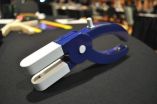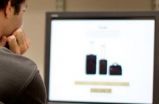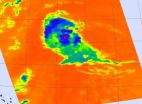(Press-News.org) After a surgeon stitches up a patient's abdomen, costly complications -- some life-threatening -- can occur. To cut down on these postoperative problems, Johns Hopkins undergraduates have invented a disposable suturing tool to guide the placement of stitches and guard against the accidental puncture of internal organs.
The student inventors have described their device, called FastStitch, as a cross between a pliers and a hole-puncher. Although the device is still in the prototype stage, the FastStitch team has already received recognition and raised more than $80,000 this year in grant and prize money to move their project forward. Among their wins were first-place finishes in University of California, Irvine, and University of Maryland business plan competitions and in the ASME International Innovation Showcase.
The FastStitch device is needed, the students say, to improve the way up to 5 million open abdominal surgeries are conducted annually in the United States alone for treatment of cancer, liver problems and other common ailments. If incisions from those procedures are not closed properly, a patient can develop complications such as infection, herniation and evisceration, all of which require additional treatment and in some cases, more surgery. Just one of these complications --herniation, in which intestinal tissue can protrude through the abdominal wall after the muscle layer splits apart -- leads to $2.5 billion in additional costs annually in follow-up treatment and medical malpractice expenses, the students said.
Addressing this problem became a biomedical engineering course assignment for eight Johns Hopkins students over the past school year. They were asked to design and test a tool that that would improve the way surgeons stitch together the strongest part of the abdomen, the muscle layer called the fascia, which is located just below the patient's skin. "Doctors who have to suture the fascial layer say it can be like pushing a needle through the leather of your shoe," said team member Luis Hererra, a sophomore biomedical engineering major from Downey, Calif. "If the needle accidentally cuts into the bowel, it can lead to a sepsis infection that can be very dangerous."
To help prevent this, the students designed the FastStitch needle to remain housed within the jaws of the stitching tool. "You place the fascial layer between the top and bottom arms of the device," said Sohail Zahid, of Morris Plains, N.J., leader of the student team. "Then, as you close the arms, the spring-loaded clamp is strong enough to punch the needle through the fascial layer. When this happens, the needle moves from one arm of the tool to the other."
The device also features a visual guide to help ensure that the stitches are placed evenly, located the proper distance away from the incision and apart from one another. This should also reduce postoperative complications, the students said. The hand-size pliers-like shape was chosen because it would feel familiar to surgeons and require less training. The prototype was constructed mostly of ABS plastic, so that the instrument can be inexpensive and discarded after one use.
"We're developing the future of suture," said Zahid, who earned his undergraduate degree in May and has applied to Johns Hopkins' M.D./Ph.D. program in biomedical engineering. "We believe that if the FastStitch tool is used to close abdominal incisions, it will help in three important ways: It will help surgeons by making the closure process simpler and safer. It will help hospitals by reducing costs. And, most importantly, it will help patients by reducing post-operative complications."
Physician Hien Nguyen, an assistant professor of surgery in the Johns Hopkins School of Medicine, served as the students' clinical advisor during the development of FastStitch. "Just about every major operation in the chest and abdomen requires a large cut to be made through the muscle layers," he said. "If these layers are not brought back together evenly, complications can occur. This device allows the surgeon to bring the muscle layers back together evenly, safely and quickly, and this can lead to better outcomes and fewer complications."
Nguyen had discussed the need for a better suture tool with the undergraduate design team in a program offered by the Department of Biomedical Engineering, which is shared by the university's School of Medicine and its Whiting School of Engineering. The course is conducted within the Center for Bioengineering Innovation and Design.
In addition to Zahid and Herrera, the other students who have participated in the FastStitch project are Andy Tu, Daniel Peng, Stephen Van Kootyen, Leslie Myint, Anvesh Annadanam and Haley Huang. Through the Johns Hopkins Technology Transfer office, the team members have obtained preliminary patent protection for their invention. All eight students are listed as co-inventors, along with Nguyen and Johns Hopkins graduate student Adam Clark.
The students have formed a Baltimore-based company, Archon Medical Technologies, to conduct further research and development of FastStitch. The company is being supported by grant funding and by most of the prize money won in the student invention and business plan contests earlier this year. Animal testing of the device is under way, and further testing with human cadavers is expected to begin later this year.
INFORMATION:
Color images and video available; contact Phil Sneiderman.
Related links:
Johns Hopkins Department of Biomedical Engineering: www.bme.jhu.edu
Center for Bioengineering Innovation & Design: http://cbid.bme.jhu.edu/
Whiting School of Engineering: http://engineering.jhu.edu/
Archon Medical Technologies: http://www.archonmed.com
Note: A video related to this release is at http://www.youtube.com/watch?v=nSx88E131oo
Could FastStitch device be the future of suture?
2012-08-16
ELSE PRESS RELEASES FROM THIS DATE:
Climate and drought lessons from ancient Egypt
2012-08-16
Ancient pollen and charcoal preserved in deeply buried sediments in Egypt's Nile Delta document the region's ancient droughts and fires, including a huge drought 4,200 years ago associated with the demise of Egypt's Old Kingdom, the era known as the pyramid-building time.
"Humans have a long history of having to deal with climate change," said Christopher Bernhardt, a researcher with the U.S. Geological Survey. "Along with other research, this study geologically reveals that the evolution of societies is sometimes tied to climate variability at all scales – whether decadal ...
3-D movies in your living room -- without the glasses
2012-08-16
Lounging on a sofa while watching a 3D movie is an exquisite pleasure for many film fans. Be that as it may, those nettlesome 3D glasses might diminish the fun somewhat. That's why television manufacturers are working on displays that can recreate the spellbinding magic of three-dimensional television images – without the glasses. Though prototypes of these TV screens already exist, consumers will not have to wait much longer for the market introduction of these autostereoscopic displays. Neverthe-less, the content might be a bit problematic: The 3D movies currently available ...
Turmeric spices up virus study
2012-08-16
Fairfax, Va.--The popular spice turmeric packs more than just flavor — it shows promise in fighting devastating viruses, Mason researchers recently discovered.
Curcumin, found in turmeric, stopped the potentially deadly Rift Valley Fever virus from multiplying in infected cells, says Aarthi Narayanan, lead investigator on the new study and a research assistant professor with Mason's National Center for Biodefense and Infectious Diseases.
Mosquito-borne Rift Valley Fever virus (RVF) is an acute, fever-causing virus that affects domestic animals such as cattle, sheep ...
Why are elderly duped? UI researchers explain why
2012-08-16
Everyone knows the adage: "If something sounds too good to be true, then it probably is." Why, then, do some people fall for scams and why are older folks especially prone to being duped?
An answer, it seems, is because a specific area of the brain has deteriorated or is damaged, according to researchers at the University of Iowa. By examining patients with various forms of brain damage, the researchers report they've pinpointed the precise location in the human brain, called the ventromedial prefrontal cortex, that controls belief and doubt, and which explains why some ...
Danes frequently confronted by religion
2012-08-16
Ramadan dinners in the Danish Parliament, staff parties without either pork or alcohol and prayer rooms at the airport are all examples of how religion is becoming more visible in public spaces.
"Prior to the mass migration of the '60s, '70s and '80s, almost all Danes shared similar values and were members of the national Christian church, so religion was not an issue in everyday life. There was no need to discuss neither one's own nor another person's religious viewpoint, and secularisation was a matter of course. Today, it is difficult to be in a public place, read ...
NASA sees System 93L explode into Tropical Storm Gordon
2012-08-16
VIDEO:
An animation of satellite observations from Aug. 13-16, 2012 shows the birth of the Atlantic Ocean hurricane season's eighth tropical depression that strengthens into Tropical Storm Gordon. This visualization was...
Click here for more information.
NASA has been watching the low pressure system called System 93L for the last week, and late on August 15 it organized into Tropical Depression 8, then Tropical Storm Gordon. NOAA's GOES-13 satellite captured a visible ...
Hubble watches star clusters on a collision course
2012-08-16
Astronomers using data from NASA's Hubble Space Telescope have caught two clusters full of massive stars that may be in the early stages of merging. The clusters are 170,000 light-years away in the Large Magellanic Cloud, a small satellite galaxy to our Milky Way.
What at first was thought to be only one cluster in the core of the massive star-forming region 30 Doradus (also known as the Tarantula Nebula) has been found to be a composite of two clusters that differ in age by about one million years.
The entire 30 Doradus complex has been an active star-forming region ...
NASA is tracking electron beams from the sun
2012-08-16
In the quest to understand how the world's weather moves around the globe, scientists have had to tease apart different kinds of atmospheric movement, such as the great jet streams that can move across a whole hemisphere versus more intricate, localized flows. Much the same must currently be done to understand the various motions at work in the great space weather system that links the sun and Earth as the sun shoots material out in all directions, creating its own version of a particle sea to fill up the solar system.
"People think of the sun as giving out light and ...
Metabolic protein wields phosphate group to activate cancer-promoting genes
2012-08-16
HOUSTON - A metabolic protein that nourishes cancer cells also activates tumor-promoting genes by loosening part of the packaging that entwines DNA to make up chromosomes, a team led by scientists at The University of Texas MD Anderson Cancer Center reports in the Aug. 16 issue of Cell.
Working in cell lines and mouse models of glioblastoma multiforme, the most lethal form of brain tumor, senior author Zhimin Lu, Ph.D., associate professor of Neuro-Oncology at MD Anderson, and colleagues show that pyruvate kinase M2 (PKM2) fuels tumor growth by influencing a histone protein.
DNA ...
Annals of Internal Medicine publishes new CDC recommendations on hepatitis C screening
2012-08-16
PHILADELPHIA, August 16, 2012 – Without other risk factors, all Americans born between 1945 and 1965 should have a one-time screening for the hepatitis C virus (HCV) according to new recommendations being published early online today in Annals of Internal Medicine, the flagship journal of the American College of Physicians. The Centers for Disease Control and Prevention (CDC) also recommends that all persons identified with HCV should receive a brief alcohol screening and intervention and be referred to appropriate care and treatment services for HCV and related conditions.
Up ...




